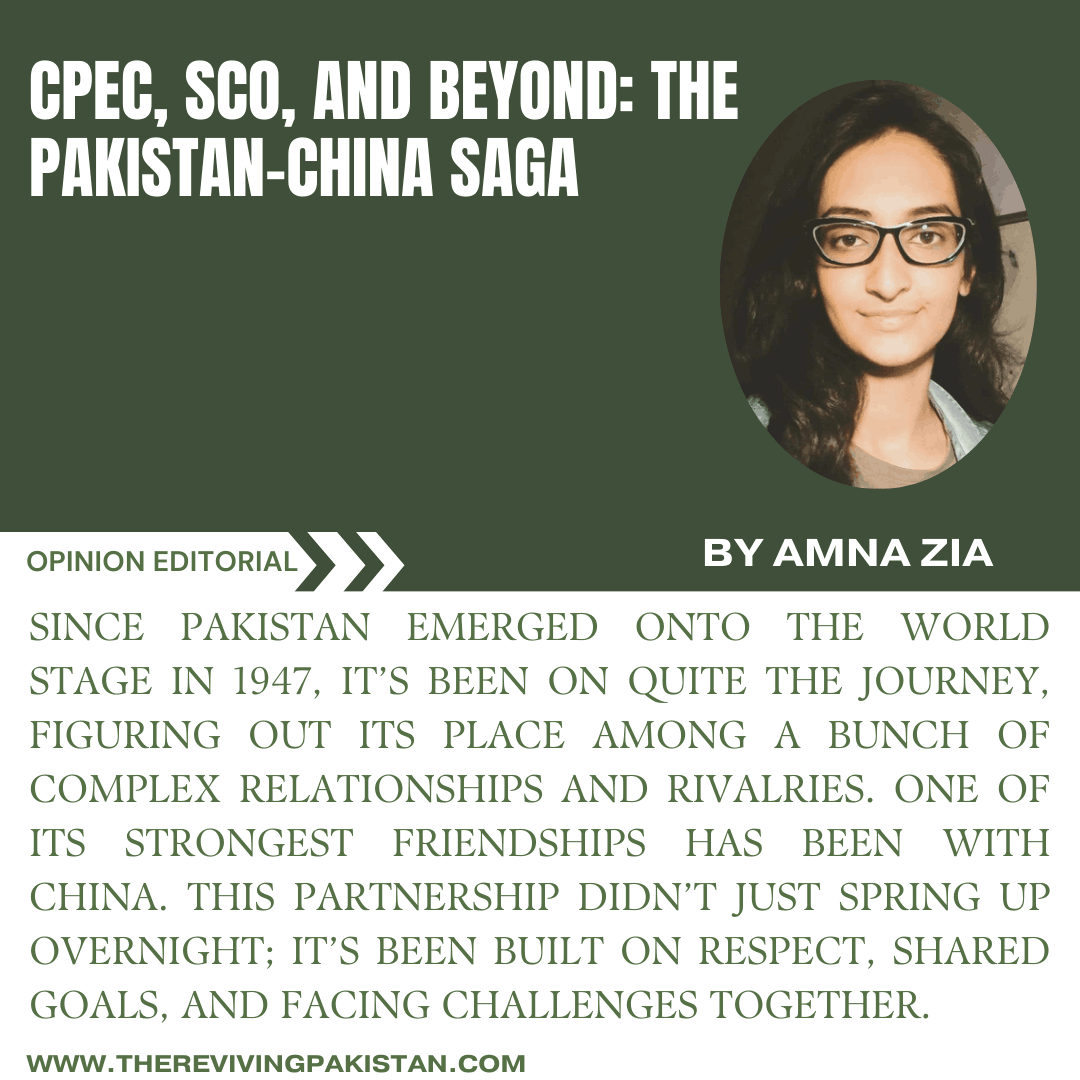Table of Contents
About the Author(s)

Amna Zia
The author is pursuing her Bachelor’s in International Relations at Bahria University, Islamabad Campus (BUIC). With a deep fascination for geopolitics, diplomatic affairs, and Pakistan’s evolving role in the global arena, she channels her insights through writing to spark constructive dialogue and shape meaningful discourse.
Introduction.
Since Pakistan emerged onto the world stage in 1947, it’s been on quite the journey, figuring out its place among a bunch of complex relationships and rivalries. One of its strongest friendships has been with China. This partnership didn’t just spring up overnight; it’s been built on respect, shared goals, and facing challenges together. As we dive into the story of how this friendship has grown over the years, we’ll see how it went from just diplomatic greetings to a solid alliance that plays a big role in shaping the politics of South Asia today.
The Early Years: Establishing Connections.
After gaining independence, Pakistan faced a mountain of challenges. The wounds from partition were still fresh, and the country was grappling with economic instability, a refugee crisis, and security worries, especially with India next door. In the midst of all this chaos, Pakistan knew it needed friends to help strengthen its position.
In 1951, Pakistan took a big step by officially recognizing the People’s Republic of China. This wasn’t just a formal handshake; it marked the start of a friendship that would withstand the test of time. Then, in 1963, both countries signed a crucial agreement to establish their border, paving the way for closer cooperation.
A Strategic Alliance Emerges.
The 1960s and 70s were game-changing years for Pakistan and China. Both nations were dealing with India’s looming threat, which brought them even closer together. While Pakistan was leaning toward the U.S. during the Cold War, China stepped in as an essential ally, providing military support and tech help.
Fast forward to the 1980s, and as Pakistan was pushing to develop its nuclear program, China played a major role in that journey. This cooperation really strengthened their bond, especially since they both viewed India’s military growth with caution. Their friendship was further solidified through joint military exercises and the sharing of crucial defense technologies.
Challenges of the 1990s: A Shift in Focus.
When the Cold War ended in the early 1990s, Pakistan faced new hurdles. With less support from Western countries and a shifting global scene, Pakistan leaned even more on China for economic help and military cooperation. This friendship became a cornerstone of Pakistan’s foreign policy, with high-level visits and diplomatic talks happening regularly.
However, this was also a tough time for Pakistan internally, with political strife and economic struggles. Luckily, China was there, standing by Pakistan and providing support even when things got rocky at home.
9/11 and Its Aftermath.
The event of September 11, 2001, changed everything, not just for the U.S. but for Pakistan, too. As Pakistan joined forces with the U.S. in the War on Terror, its foreign policy had to shift. This alliance, while necessary, put Pakistan in a tricky spot, facing a lot of scrutiny from the world.
In the aftermath of 9/11, Pakistan got caught up in various conflicts, including the U.S.-led invasion of Afghanistan. This led to increased militancy within Pakistan and strained relations with different groups. But through all this chaos, China was still there, offering vital economic and military support. Their unwavering partnership really showed how deep their friendship ran during tough times.
The Dawn of CPEC: A New Chapter.
In 2015, the launch of the China-Pakistan Economic Corridor (CPEC) marked a new and exciting phase in their relationship. CPEC is a huge initiative aimed at boosting economic development through a bunch of infrastructure projects like roads, railways, and energy installations.
Key Projects Under CPEC:
- Gwadar Port Development: This strategic port on the Arabian Sea is set to become a key hub for trade, connecting Pakistan to China’s western regions and giving Pakistan a significant economic boost.
- Energy Projects: CPEC includes several energy initiatives aimed at solving Pakistan’s ongoing energy crisis, with plans for coal, wind, solar, and hydropower plants.
- Infrastructure Development: The corridor involves building highways and railways to improve connectivity across Pakistan, enhancing trade not just with China but also with Central Asia.
Economic Impact:
CPEC is expected to create thousands of jobs and attract lots of foreign investment. These projects could seriously boost Pakistan’s GDP and improve living standards across the country. However, some critics are concerned about a potential “debt trap,” where Pakistan might struggle to repay loans to China, raising worries about its sovereignty and long-term economic health.
Public Sentiment: While many Pakistanis see CPEC as a pathway to progress, others worry about its environmental effects and the potential for China to have too much political influence.
Navigating the Current Geopolitical Landscape.
As we entered the 2020s, the world became even more complicated geopolitically. The rivalry between the U.S. and China heated up, and Pakistan found itself juggling relationships with both countries. With the U.S. withdrawing from Afghanistan, Pakistan’s importance for regional stability became clearer than ever.
In this context, joining the Shanghai Cooperation Organization (SCO) in 2017 was a significant move for Pakistan, marking a deeper partnership with China and other regional players. The SCO, which started in 2001, focuses on regional security, economic cooperation, and cultural exchange, with a big emphasis on tackling terrorism and promoting stability in Central Asia.
SCO’s Role in Regional Stability.
The organization offers a platform for member states to work together on counter-terrorism, share intelligence, and kickstart economic initiatives. For Pakistan and China, the SCO is a great opportunity to tackle shared security concerns, especially regarding extremism and maintaining regional stability.
Ongoing SCO Conference.
Right now, the SCO conference is happening in Pakistan from October 15 to 17, 2024. The theme of the 2024 SCO summit is “Strengthening Multilateral Dialogue—Striving Towards a Sustainable Peace and Prosperity,” focusing on regional cooperation in areas such as economic growth, security, and sustainable development. Key topics on the agenda include stability in Afghanistan, counter-terrorism efforts, and boosting trade and investment among member states. With leaders and representatives from different countries attending, this conference shows how crucial Pakistan’s role is in fostering dialogue and cooperation in the region.
Critical Analysis: Examining the Pakistan-China Partnership.
The friendship between Pakistan and China is undeniably strong, symbolizing resilience and mutual trust built over decades. However, it’s important to acknowledge the complexities that come with such a deep alliance. While projects like the China-Pakistan Economic Corridor (CPEC) promise to transform Pakistan’s economy by creating jobs, improving infrastructure, and boosting trade, there are underlying concerns. Critics worry about a potential “debt trap,” where Pakistan could struggle to repay Chinese loans, raising questions about sovereignty and financial dependence.
Furthermore, the benefits of CPEC have not been evenly distributed, with some regions and communities not experiencing the same economic uplift as others. The environmental impact of certain projects and the risk of increasing Chinese political influence in Pakistan are also valid points of concern.
On the geopolitical front, the relationship brings its own set of challenges. As the rivalry between the U.S. and China intensifies, Pakistan finds itself in a delicate position, having to balance ties with both powers. This balancing act is crucial for Pakistan to avoid overreliance on any one country while maintaining a strong stance in a rapidly changing global environment. As the world becomes more multipolar, managing these dynamics will be essential to ensure that the benefits of the China-Pakistan partnership continue to outweigh the risks.
Conclusion: A Friendship for the Future.
Despite the challenges, the Pakistan-China friendship stands as a beacon of hope and a model of resilience in international relations. From the early days of diplomatic recognition to ambitious projects like CPEC and collaboration in security through the SCO, their relationship has continuously adapted to meet the demands of a changing world.
Looking ahead, this enduring alliance is poised to play a key role in Pakistan’s journey toward greater stability, economic development, and an enhanced global presence. The strength of their partnership goes beyond economic deals and strategic interests—it is reflected in their ability to support each other through turbulent times and adjust to new realities while striving for shared growth and prosperity. As both nations navigate an increasingly interconnected world, their friendship remains a vital element of regional stability and a driving force for a future filled with opportunity.

